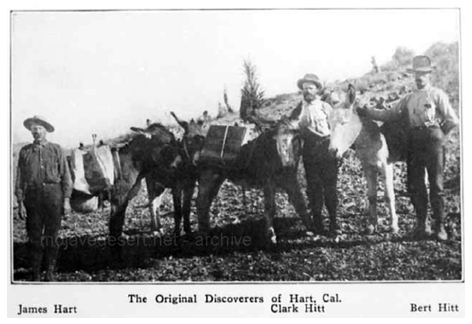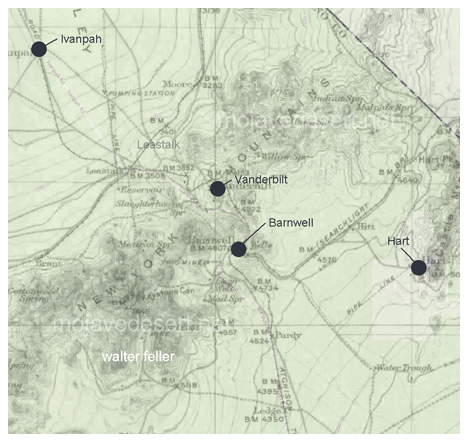Desert Fever - San Bernardino County:
Hart
 On December 19, 1907, Jim Hart, with Bert and Clark Hitt, discovered gold, soon transforming a corner of the eastern Mojave into the thriving town of Hart. By January there was a "stampede to Hart" with people leaving Needles and Searchlight "in automobiles, buggies, wagons and on bicycles and burros." Many men came from Goldfield, Nevada. By the end of the month, telephone wires that connected with the Western Union at Barnwell had been strung up, and an estimated 200 men were in camp, working leases on the claims that had been staked. 184
On December 19, 1907, Jim Hart, with Bert and Clark Hitt, discovered gold, soon transforming a corner of the eastern Mojave into the thriving town of Hart. By January there was a "stampede to Hart" with people leaving Needles and Searchlight "in automobiles, buggies, wagons and on bicycles and burros." Many men came from Goldfield, Nevada. By the end of the month, telephone wires that connected with the Western Union at Barnwell had been strung up, and an estimated 200 men were in camp, working leases on the claims that had been staked. 184
February had seen considerable excitement in the young town, with gunplay and litigation over the townsite and some of the original mining claims. There were about 600 to 700 people in the camp. The much anticipated water line from Barnwell was completed by the beginning of March, and in April a siding was built on the Barnwell and Searchlight Railroad. The siding was named Hitt, in honor of one of the discoverers, and a freight house was constructed there. 185
Daily mail service had begun by April 1, even though a post office was not established until April 30. A businessmen's league was organized, in order to "encourage legitimate mining," and a law-and-order committee of the league was formed "to assist in the maintenance of a quiet camp." 186

Townspeople celebrated with a banquet and a ball the opening in April of the first class two-story Norton House hotel. In May buildings were going up all over the town, and "many substantial business blocks" were being constructed. Also in May a Little Giant mill, with a capacity of eight tons arrived from Goldfield. This mill was purchased by George Foster, owner of the Big Chief, and Hart and Hitt, owners of the Oro Belle Number One. The mill was installed, but the poorly constructed foundation literally vibrated apart by the heavy machinery, and it was not until November that, with modifications, the mill was finally running. 187
Summer was a busy time in Hart. Another two-story hotel, the Martin House, was constructed. There were two general stores, a one-story rooming house, a bookstore, real estate offices, a candy store, two lumberyards, a bakery, and eight saloons. From early 1908 until about November, 1909, Hart had a newspaper named the Enterprise . There even was a cemetery that was the final resting place for five souls. A son born to Mr. and Mrs. Emory C. Peters in May, 1908, was the first child born in Hart, and as a token of honor, they were promised a golden loving cup to be made from Hart gold. 188
It was not until July that the first major ore shipment was made from Hart. This ore was treated at the Cyrus Noble mill in Searchlight. Nearly all the ore from Hart was shipped to Searchlight for milling at a cost of $3 a ton. 189
After the excitement of the first year, things settled down to just hard work extracting gold-rich rock from the mines. The principal mines were the Oro Belle, purchased from Hart and Hill in April, 1908, the Big Chief, the Sloan lease on the Jumbo claim, the Quartette shaft on the Jumbo claim, the Oro Belle Number One and Oro Belle Number Two. The Oro Belle One and Two were worked by Hart and Hitt until November, 1908, when it was purchased by A. B. Hall of Philadelphia, Pennsylvania. The Quartette shaft was being sunk by the Quartette Mining Company of Searchlight. The Jumbo was operated by the Big Chief group who built a twenty-stamp mill, probably in 1910. Indeed, there are ruins of a substantial mill about 1 mile south of the site of Hart. 190
Sparks from a chimney ignited a fire that destroyed much of Hart during the last week of December, 1910. The fire destroyed the Martin Hotel, the townsite office, a general store and other buildings. Although these buildings were never rebuilt, Hart lived on, and the mines continued. 191
In 1913 Hart became a boom town of a different sort. Many people began taking up homesteads in that area. Two men passed through Barstow in June on their way there, for the purpose of erecting "several buildings on their business property," probably to supply the incoming homesteaders with supplies. In 1915 the Tonopah and Belmont Company optioned the Oro Belle and worked it for awhile. The post office shut its doors December 31, 1915. 192
About 1 mile south of Hart, the Standard Sanitary Manufacturing Company mined clay from time to time after 1929. Another clay quarry was opened immediately adjacent and to the east of the site of Hart in 1947. In September, 1974, the mill structure at this quarry was in the process of being dismantled. A Quonset hut bunkhouse which was standing near the quarry in 1974 has since been razed. However, both clay mines remain intermittently active.
Only a chimney remains at Hart, and one collapsed stone building about 1/4 mile south. Yet there are possible signs of life. Transcorp, a Los Angeles based company, leased the patented Oro Belle Mine (owned by the Baghdad Chase Company) on February 24, 1978. They have thoroughly sampled the mine and may reactivate it. 193
Goldfield
Baghdad - Chase